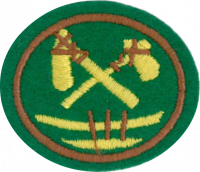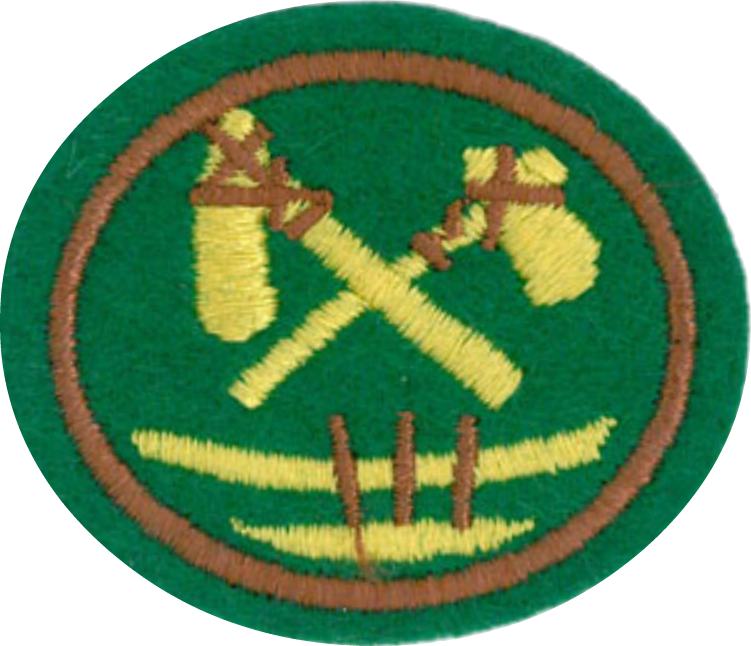|
|
| (18 intermediate revisions by 2 users not shown) |
| Line 1: |
Line 1: |
| − | <languages /><br />
| + | {{HonorSubpage}} |
| − | <noinclude></noinclude>
| |
| − | {{honor_desc/es | |
| − | |stage=00
| |
| − | |honorname=Construcción de canoas
| |
| − | |skill=3
| |
| − | |category=Actividades recreacionales
| |
| − | |authority=Asociación General
| |
| − | |insignia=Canoe_Building.png}}
| |
| − | | |
| − | | |
| − | <noinclude></noinclude>
| |
| | <section begin="Body" /> | | <section begin="Body" /> |
| | {{ansreq|page={{#titleparts:{{PAGENAME}}|2|1}}|num=1}} | | {{ansreq|page={{#titleparts:{{PAGENAME}}|2|1}}|num=1}} |
| Line 38: |
Line 27: |
| | {{ansreq|page={{#titleparts:{{PAGENAME}}|2|1}}|num=4}} | | {{ansreq|page={{#titleparts:{{PAGENAME}}|2|1}}|num=4}} |
| | <noinclude></noinclude> | | <noinclude></noinclude> |
| − | <!-- 4. Elegir un buen árbol para canoas de alrededor de 4 metros de longitud y observar la correcta tala del mismo. Explicar lo que pasó. --> | + | <!-- 4. Elegir un buen árbol para canoas de alrededor de 4 metros de longitud y observar la correcta tala del mismo. Explicar lo que pasó. --> |
| | | | |
| − | {{clear}} | + | {{clear}} |
| | | | |
| | <noinclude></noinclude> | | <noinclude></noinclude> |
| Line 54: |
Line 43: |
| | {{ansreq|page={{#titleparts:{{PAGENAME}}|2|1}}|num=6}} | | {{ansreq|page={{#titleparts:{{PAGENAME}}|2|1}}|num=6}} |
| | <noinclude></noinclude> | | <noinclude></noinclude> |
| − | <!-- 6. With the help of others properly shape the outside of the canoe and hollow out the inside. Correctly smooth both surfaces inside and outside. --> | + | <!-- 6. Con la ayuda de otros, dar forma de manera correcta a la parte exterior de la canoa y hacer el hueco interior. Correctamente suavizar ambas superficies tanto dentro como afuera. --> |
| − | [[File:Dcp 5863.jpg|thumb|400px|Building a sea-going dugout canoe 10 meters (33 ft) long]]
| |
| − | Before the appearance of metal tools, dugouts were hollowed-out using controlled fires. The burnt wood was then removed using an adze. Another method using tools is to chop out parallel notches across the interior span of the wood, then split out and remove the wood from between the notches. Once hollowed out, the interior is dressed and smoothed out with a knife or adze.
| |
| | | | |
| − | The ends are tapered to reduce drag in the water.
| + | {{clear}} |
| | | | |
| − | To shape the hull so that it has an even thickness, bore several small, evenly spaced holes in the hull. These are then plugged with pegs, the length of which equals the desired thickness of the hull. The pegs are inserted from the outside until they are flush with the surface of the hull. The inside is then hollowed until the ends of the pegs are reached. When the boat is placed in the water, the pegs will swell and the holes will be water-tight.
| + | {{clear}} |
| | | | |
| − | As the hull becomes thin, the canoe is inverted over a fire to heat the wood, making it more pliable. The gunwales are then spread apart, greatly increasing the interior room in the craft. Spacers are then placed over the gunwales to hold them apart as the log cools, and the boat retains this shape.
| + | {{clear}} |
| | | | |
| | {{clear}} | | {{clear}} |
| Line 70: |
Line 57: |
| | {{ansreq|page={{#titleparts:{{PAGENAME}}|2|1}}|num=7}} | | {{ansreq|page={{#titleparts:{{PAGENAME}}|2|1}}|num=7}} |
| | <noinclude></noinclude> | | <noinclude></noinclude> |
| − | <!-- 7. Assist in the making of paddles, seats, poles and fittings for the canoe. --> | + | <!-- 7. Ayudar en la elaboración de remos, asientos, postes y accesorios de la canoa. --> |
| − | ===Paddles===
| |
| − | Paddles are typically carved from long wooden poles. The blade is made wide and thin, tapering out at the edges. The shaft is rounded, and is thicker than the blade to give it extra strength. The grip will be another wide, flat section and is parallel to the blade and fitted to the user's hand.
| |
| | | | |
| − | When making a paddle, the craftsman will be trading strength for weight, and this is a delicate balance to strike. If the paddle is too heavy, it will easily and unnecessarily tire its user. But if it is too light, it will lose strength and may break when stressed. Usually a paddle is stressed at the most inopportune times - they experience very little stress in calm, flat water when it wouldn't be much of a problem if it broke.
| + | {{clear}} |
| | | | |
| − | ===Seats===
| + | {{clear}} |
| − | The seats are made from wood which is shaped and fitted over the gunwales. They are shaped such that the bottom of the seat is lower than the gunwales. The seat will lift off the gunwales. When the canoe is dragged up onto the beach, the paddler will take both the paddle and the seat into his home.
| |
| | | | |
| − | ===Poles===
| + | {{clear}} |
| − | The poles, like the paddles trade weight for strength. They are typically the same (or nearly the same) diameter from top to bottom. The length depends on the depth of the water in which they are used. Poles are used from a standing position, and the length reflects this.
| |
| | | | |
| | <noinclude></noinclude> | | <noinclude></noinclude> |
| Line 86: |
Line 69: |
| | {{ansreq|page={{#titleparts:{{PAGENAME}}|2|1}}|num=8}} | | {{ansreq|page={{#titleparts:{{PAGENAME}}|2|1}}|num=8}} |
| | <noinclude></noinclude> | | <noinclude></noinclude> |
| − | <!-- 8. Assist in the construction of decking, outrigger, mast and sail if the canoe is of a double hull or outrigger type. --> | + | <!-- 8. Ayudar en la construcción de cubiertas, soportes adicionales, mástil y vela, si la canoa es de doble casco o de la clase de soportes adicionales. --> |
| − | ===Decking===
| |
| − | Not all dugouts were outfitted with decks, but when present, decking is placed at both ends of the canoe to keep breaking waves from filling the boat. They help the boat to shed water. Decks are flat pieces of wood connected to the edges of the canoe and can be lashed in place by boring holes in both the hull (near the upper edge) and the deck. Once the deck has been lashed in place, the holes are sealed with pitch.
| |
| | | | |
| − | ===Outrigger===
| + | {{clear}} |
| − | Outriggers of New Zealand consist of three parts: a pair of booms, connecting pegs, and a float. One boom is lashed to the canoe near the bow, and the other is lashed near the stern. Holes are bored into the hull directly below the booms so that cordage can be passed through them when lashing.
| |
| | | | |
| − | Each boom receives long pegs which are then connected to the float. The length of the pegs is adjusted so that the float will be positioned at the surface of the water. The pegs are lashed both to the booms and to the float. When lashing the pegs to the floats, a hole is bored through the float and the cordage is passed through it. This prevents the lashing from being positioned at the bottom of the float where it would be subjected to extreme wear and tear as the canoe is dragged across rocks and up onto beaches.
| + | {{clear}} |
| | | | |
| − | The float is typically pointed at the bow end and square at the stern.
| + | {{clear}} |
| | | | |
| − | ===Mast and Sail===
| + | {{clear}} |
| − | If a canoe is outfitted with a mast and sail, it should also have outriggers. Otherwise, it can easily be toppled by the wind.
| |
| | | | |
| − | The mast is roughly {{units|4 meters|160 in}} long and tapers from {{units|28 mm|1.125 inches}} at the top to {{units|45 mm|1.75 in}} at the bottom. It is inserted into a hole in the seat, and then into a socket cut into the bottom of the boat to receive it.
| + | {{clear}} |
| − | [[File:Dugout boom.png|thumb|300px|Boom shoulders. The right side is the mast-end.]]
| |
| − | A few inches above the seat it is fastened to a boom. The boom is the same length and diameter as the mast. Shoulders are cut near both ends, with the mast-end having a deeper shoulder (see illustration).
| |
| | | | |
| − | The boom is simply tied to the mast, and the sail is tied to both the mast and the boom. The sail itself is triangular.
| |
| | {{clear}} | | {{clear}} |
| − | See http://www.mit.edu/people/robot/lepalepa/index.html for detailed drawings.
| |
| | | | |
| | <noinclude></noinclude> | | <noinclude></noinclude> |
| Line 112: |
Line 87: |
| | {{ansreq|page={{#titleparts:{{PAGENAME}}|2|1}}|num=9}} | | {{ansreq|page={{#titleparts:{{PAGENAME}}|2|1}}|num=9}} |
| | <noinclude></noinclude> | | <noinclude></noinclude> |
| − | <!-- 9. Make a tree model of the type of canoe used in your district. --> | + | <!-- 9. Hacer un modelo de árbol de la clase de canoa utilizada en su distrito. --> |
| − | Choose a soft wood and shape the model as closely as you can to match your canoe. People will often carve a scale model before beginning to shape the log. The model can then be used as a reference.
| |
| | | | |
| | <noinclude></noinclude> | | <noinclude></noinclude> |
| | {{CloseReq}} <!-- 9 --> | | {{CloseReq}} <!-- 9 --> |
| | <noinclude></noinclude> | | <noinclude></noinclude> |
| − | ==Reference== | + | ==Referencias== |
| − | * http://www.greatdreams.com/canoe2.htm
| |
| − | * http://www.nzetc.org/tm/scholarly/tei-BucSamo-t1-body1-d7-d1-d4.html
| |
| − | * http://www.willghormley-maker.com/MakinADugoutCanoe.html
| |
| − | [[Category:Adventist Youth Honors Answer Book|{{SUBPAGENAME}}]]
| |
| | <noinclude></noinclude> | | <noinclude></noinclude> |
| − | <section end="Body" />
| + | {{CloseHonorPage}} |


